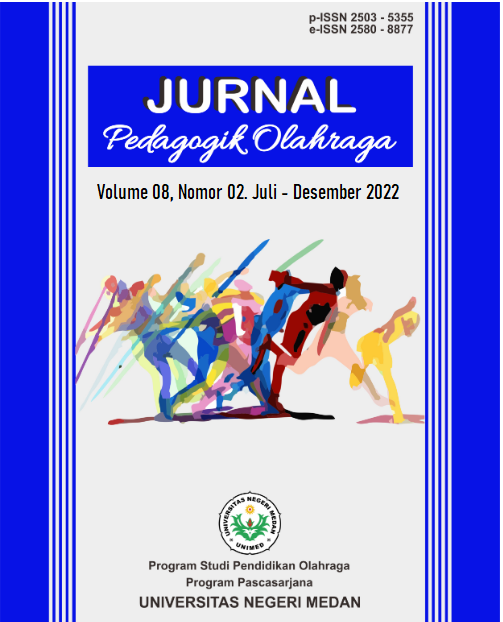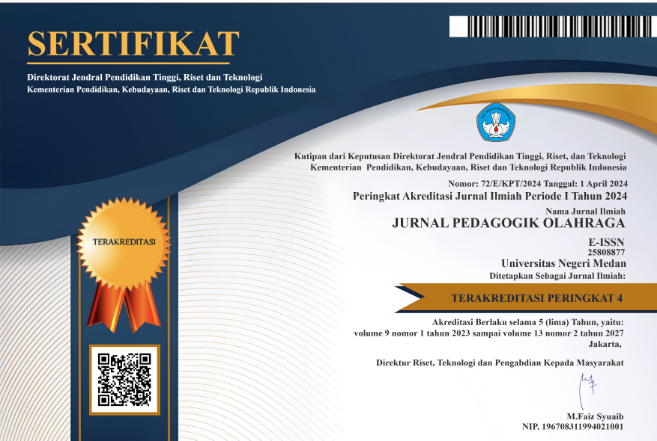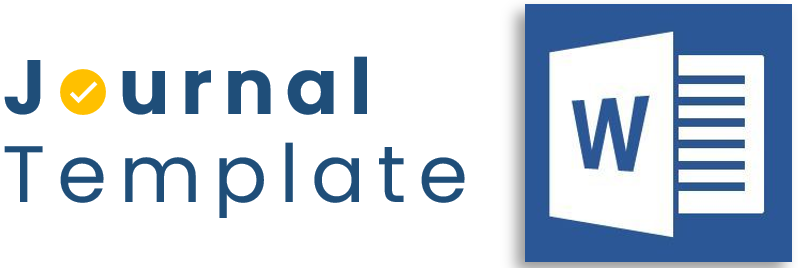ANALISIS WAKTU REAKSI PADA KELOMPOK REMAJA DENGAN GAYA HIDUP AKTIF (KAJIAN PADA KONDISI KELELAHAN DAN PASCA RECOVERY AKTIF)
DOI:
https://doi.org/10.24114/jpor.v9i1.46612Keywords:
Waktu reaksi, Kelelahan, Gaya Hidup AktifAbstract
Tujuan dari penelitian ini adalah untuk mengetahui waktu reaksi pada kelompok remaja dengan gaya hidup aktif. Adapun jenis penelitian adalah deskriptif kuantitatif dengan menggunakan metode survei. Sampel dalam penelitian ini adalah remaja dengan usia 17-18 tahun berjumlah 30 orang. Teknik pengumpulan data dengan tes dan pengukuran serta instrumen yang digunakan adalah tes reaksi menggunakan penggaris 30 cm. teknik analisis data menggunakan rumus deskriptif presentase. Hasil penelitian menunjukkan bahwa secara berturut-turut ditemukan tidak terdapat sampel yang memiliki waktu reaksi pada kategori istimewa, kisaran 20-23% peserta masuk dalam kategori sangat kurang, disusul dengan sekitar 11-13% merupakan orang-orang dengan kategori waktu reaksi bagus/bagus sekali dan yang terakhir persentase tertinggi sekitar 30-34% sampel memiliki waktu reaksi dalam kategori cukup dan kurang. Kesimpulan dari penelitian ini adalah tidak terdapat perbedaan yang sangat signifikan antara kondisi sebelum aktivitas fisik, kelelahan dan pasca recovery. Temuan ini disebabkan oleh karakteristik sampel yang homogen. Kajian lanjutan yang disarankan adalah menguji waktu reaksi dengan sampel acak atau heterogen dan melakukan korelasi antar variabelnya.References
Adleman, N. E., Chen, G., Reynolds, R. C., Frackman, A., Razdan, V., Weissman, D. H., Pine, D. S., & Leibenluft, E. (2016). Age-related differences in the neural correlates of trial-to-trial variations of reaction time. Developmental Cognitive Neuroscience, 19, 248“257. https://doi.org/10.1016/j.dcn.2016.05.001
Badau, D., Baydil, B., & Badau, A. (2018). Differences among Three Measures of Reaction Time Based on Hand Laterality in Individual Sports. Sports, 6(2), 45. https://doi.org/10.3390/sports6020045
Calvo, M. G., & Avero, P. (2009). Reaction time normative data for the IAPS as a function of display time, gender, and picture content. Behavior Research Methods, 41(1), 184“191. https://doi.org/10.3758/BRM.41.1.184
Dharmastuti, D. P., Agni, A. N., Widyaputri, F., Pawiroranu, S., Sofro, Z. M., Wardhana, F. S., Haryanto, S., Widayanti, T. W., Kotha, S., Gupta, P., & Sasongko, M. B. (2018). Associations of Physical Activity and Sedentary Behaviour with Vision-Threatening Diabetic Retinopathy in Indonesian Population with Type 2 Diabetes Mellitus: Jogjakarta Eye Diabetic Study in the Community (JOGED.COM). Ophthalmic Epidemiology, 25(2), 113“119. https://doi.org/10.1080/09286586.2017.1367410
Di Liegro, Schiera, Proia, & Di Liegro. (2019). Physical Activity and Brain Health. Genes, 10(9), 720. https://doi.org/10.3390/genes10090720
Jain, A., Bansal, R., Kumar, A., & Singh, K. (2015). A comparative study of visual and auditory reaction times on the basis of gender and physical activity levels of medical first year students. International Journal of Applied and Basic Medical Research, 5(2), 124. https://doi.org/10.4103/2229-516X.157168
Kao, S.-C., Westfall, D. R., Soneson, J., Gurd, B., & Hillman, C. H. (2017). Comparison of the acute effects of high-intensity interval training and continuous aerobic walking on inhibitory control. Psychophysiology, 54(9), 1335“1345. https://doi.org/10.1111/psyp.12889
Kelly, K. M., Kiderman, A., Akhavan, S., Quigley, M. R., Snell, E. D., Happ, E., Synowiec, A. S., Miller, E. R., Bauer, M. A., Oakes, L. P., Eydelman, Y., Gallagher, C. W., Dinehart, T., Schroeder, J. H., & Ashmore, R. C. (2019). Oculomotor, Vestibular, and Reaction Time Effects of Sports-Related Concussion: Video-Oculography in Assessing Sports-Related Concussion. Journal of Head Trauma Rehabilitation, 34(3), 176“188. https://doi.org/10.1097/HTR.0000000000000437
Metin, B., Wiersema, J. R., Verguts, T., Gasthuys, R., van Der Meere, J. J., Roeyers, H., & Sonuga-Barke, E. (2016). Event rate and reaction time performance in ADHD: Testing predictions from the state regulation deficit hypothesis using an ex-Gaussian model. Child Neuropsychology, 22(1), 99“109. https://doi.org/10.1080/09297049.2014.986082
Okubo, Y., Schoene, D., & Lord, S. R. (2017). Step training improves reaction time, gait and balance and reduces falls in older people: a systematic review and meta-analysis. British Journal of Sports Medicine, 51(7), 586“593. https://doi.org/10.1136/bjsports-2015-095452
Paul, D. J., Gabbett, T. J., & Nassis, G. P. (2016). Agility in Team Sports: Testing, Training and Factors Affecting Performance. Sports Medicine, 46(3), 421“442. https://doi.org/10.1007/s40279-015-0428-2
Sant™Ana, J., Franchini, E., da Silva, V., & Diefenthaeler, F. (2017). Effect of fatigue on reaction time, response time, performance time, and kick impact in taekwondo roundhouse kick. Sports Biomechanics, 16(2), 201“209. https://doi.org/10.1080/14763141.2016.1217347
Woods, D. L., Wyma, J. M., Yund, E. W., Herron, T. J., & Reed, B. (2015). Factors influencing the latency of simple reaction time. Frontiers in Human Neuroscience, 9. https://doi.org/10.3389/fnhum.2015.00131
World Health Organisation. (2011). Physical Activity Recommendations 5-17 Years. Who, 1(1), 1“2. https://doi.org/10.1097/PAS.0b013e31827ab703
Downloads
Published
How to Cite
Issue
Section
License
Copyright (c) 2023 Jurnal Pedagogik Olahraga

This work is licensed under a Creative Commons Attribution 4.0 International License.
Jurnal Pedagogik Olahraga is licensed under a Creative Commons Attribution 4.0 International License
Penulis yang menerbitkan jurnal ini menyetujui persyaratan berikut:
- Penulis memegang hak cipta dan memberikan hak jurnal untuk publikasi pertama dengan karya yang dilisensikan secara bersamaan di bawah Lisensi Atribusi Creative Commons yang memungkinkan orang lain untuk membagikan karya tersebut dengan pengakuan atas penulisan karya dan publikasi awal dalam jurnal ini.
- Penulis dapat membuat pengaturan kontrak tambahan yang terpisah untuk distribusi non-eksklusif dari versi terbitan jurnal dari karya tersebut (misalnya, mempostingnya ke penyimpanan institusional atau menerbitkannya dalam sebuah buku), dengan pengakuan dari publikasi awalnya di jurnal ini.
- Penulis diizinkan dan didorong untuk memposting karya mereka secara online (misalnya, di repositori institusional atau di situs web mereka) sebelum dan selama proses pengiriman, karena hal itu dapat mengarah pada pertukaran yang produktif, serta kutipan yang lebih awal dan lebih besar dari karya yang diterbitkan.









